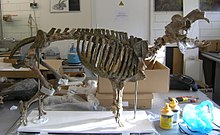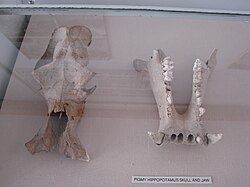| Cypriot pygmy hippopotamus Temporal range:
Pleistocene to Early
Holocene,
| |
|---|---|

| |
| Composite mounted skeleton of H. minor | |
|
Scientific classification
| |
| Domain: | Eukaryota |
| Kingdom: | Animalia |
| Phylum: | Chordata |
| Class: | Mammalia |
| Order: | Artiodactyla |
| Family: | Hippopotamidae |
| Genus: | Hippopotamus |
| Species: | †H. minor
|
| Binomial name | |
| †Hippopotamus minor | |
| Synonyms | |
| |
The Cypriot pygmy hippopotamus (Hippopotamus minor or Phanourios minor) is an extinct species of dwarf hippopotamus that inhabited the island of Cyprus from the Pleistocene until the early Holocene.
History of discovery and taxonomy
Bones of fossil mammals have been known on Cyprus since at least the 15th century, when Cypriot historian Leontios Machairas reported that bones exposed in the Kyrenia/Pentadactylos mountains in the northern part of Cyprus were believed by locals to be the bones of Maronite Christians who had fled to the island, which they regarded as saints. An account from a later historian, Benedetto Bordone published in 1528, reporting on a similar deposit in the same region, recounted that locals ground the bones into powder to make a potion they thought could cure many diseases. In 1698, the Dutch traveller Cornelis de Bruijn recounting another similar deposit in the region, made several images of bones he found in the deposit, which he thought were deposited by the Biblical great flood. The remains in one of these images, which he identified as human, is now retrospectively identified as remains of the Cypriot pygmy hippopotamus. [2]
The earliest scentific description of the species was given by French paleontologist Anselme Gaëtan Desmarest in 1822, who gave the current name Hippopotamus minor. The species Hippopotamus minutus named shortly after by Georges Cuvier in 1824 is now regarded as a junior synonym. [3] Both authors were unaware of the origin of the specimens which were in the collections of a French museum in Paris, with Desmarest and Cuvier both suggesting that the specimens originated from southern France. Additional remains of the species were collected from Cyprus by British paleontologist Dorothea Bate in 1901, which led Charles Immanuel Forsyth Major to recognise material in the Paris collection as also originating from Cyprus. [4] The species is now known from over 20 localities across the island. [5] In 1972, the species was placed in the new genus Phanourios by Paul Yves Sondaar and Gijsbert Jan Boekschoten after Saint Phanourios which local Cypriots associated with its bones. [6] However this placement has been questioned due to the fact that it is widely agreed that the species descends from a species of the genus Hippotamus, and other authors have continued to use the combination Hipppoptamus minor. [7] [8]
Evolution
A partial mitochondrial genome obtained from H. minor suggests that its closest living relative is the common hippopotamus (Hippopotamus amphibius), with an estimated genetic divergence between 1.36 to 1.58 million years ago. [7] The ancestor of the Cyprus dwarf hippopotamus is uncertain, but is likely either H. amphibius [7] or the extinct species Hippopotamus antiquus. [9] The timing of the colonisation is uncertain, though the earliest fossils date to around 219-185,000 years ago, during the late Middle Pleistocene. [7] Due to Cyprus never having been connected to the mainland, its ancestors must have arrived via crossing the Mediterranean, perhaps during a rare cataclysmic flooding event. [10] Its small body size is due to insular dwarfism, a common phenomenon on islands. [7]
Description and ecology

The Cypriot pygmy hippopotamus was roughly the same size as the extant African pygmy hippopotamus (Choeropsis liberiensis), with an estimated body mass of around 130 kilograms (290 lb). [7] H. minor is the smallest hippopotamus of all known insular hippopotamuses. It is estimated to have measured 70 cm (2.3 ft) tall and 125 cm (4.1 ft) long. [2] Compared to H. amphibius, the muzzle region of the skull is much shorter, and the skull as a whole resembles that of the pygmy hippopotamus. [8] Unlike other species of the genus Hippopotamus, the lower fourth premolar has been lost. [9] The teeth of H. minor are more brachydont (less high crowned) than those of H. amphibius, suggesting that H. minor probably occupied a browsing niche, in contrast to the grazing predominant diet of modern Hippopotamus amphibius, though its diet is likely to have varied in correspondence to glacial cycle-induced climatic changes. [11] Analysis of the limb and hand bones suggests that it was more terrestrial than its living relatives, and capable of moving on the rugged terrain of Cyprus, with changes including the shortening of the distal (closest to foot) part of the legs, and increased robustness of the limb bones, [12] [9] though it was likely incapable of running quickly. [2]
Paleoenvironment
During the Late Pleistocene, the Cypriot pygmy hippopotamus, along with the similarly sized Cyprus dwarf elephant, were the only large mammals native to the islands, and one of only four native terrestrial mammal species, alongside the still living Cypriot mouse and the extinct genet species Genetta plesictoides, [13] and had no natural predators. [14] Remains of the dwarf hippopotamus are abundant at localities where it is found, considerably moreso than the dwarf elephant. [5]
Extinction
The youngest remains of the species date to the end of the Pleistocene, around 13-12,000 years ago, around the same time as the youngest remains of the dwarf elephant species. [15] Over 200,000 bones of H. minor, representing over 500 individuals, are associated with human artifacts at the Aetokremnos rockshelter on the southern coast of Cyprus, dating to approximately 13-12,000 years Before Present, representing among the youngest records of the species, which is suggested by some authors to provide evidence that the Cypriot pygmy hippopotamus was hunted and driven to extinction by the early human residents of Cyprus. [16] [17] [18] [19] However, these suggestions have been contested, with an alternative proposal that bones at Aetokremnos accumulated naturally over hundreds of years, with the human occupation of the site after the bones were initially deposited. [15] [20]
See also
- Cretan dwarf hippopotamus
- Maltese dwarf hippopotamus
- Sicilian dwarf hippopotamus
- Cyprus dwarf elephant
References
- ^ Desmarest, A.G., 1822. Mammalogie ou description des espèces de mammifères. Mme Veuve Agasse imprimeur édit., Paris, 2ème part., pp.277-555.
- ^ a b c van der Geer, Alexandra; Lyras, George; de Vos, John; Dermitzakis, Michael (2010-08-13). "Cyprus". Evolution of Island Mammals: Adaptation and Extinction of Placental Mammals on Islands (1 ed.). Wiley. pp. 34–42. doi: 10.1002/9781444323986.ch4. ISBN 978-1-4051-9009-1.
- ^ D.A. Hooijer Notes on some Pontian mammals from Sicily, figured by Seguenza Archives Néerlandaises de Zoologie, 7 (1946), pp. 301-333
- ^ van der Geer, Alexandra; Lyras, George; de Vos, John; Dermitzakis, Michael (2010-08-13). "Hippopotamuses and Pigs". Evolution of Island Mammals: Adaptation and Extinction of Placental Mammals on Islands (1 ed.). Wiley. p. 344. doi: 10.1002/9781444323986.ch25. ISBN 978-1-4051-9009-1.
- ^ a b Athanassiou, Athanassios; Herridge, Victoria; Reese, David S.; Iliopoulos, George; Roussiakis, Socrates; Mitsopoulou, Vassiliki; Tsiolakis, Efthymios; Theodorou, George (August 2015). "Cranial evidence for the presence of a second endemic elephant species on Cyprus". Quaternary International. 379: 47–57. doi: 10.1016/j.quaint.2015.05.065.
- ^ Boekschoten G.J., Sondaar P.Y. 1972. On the fossil mammalia of Cyprus, I & II. Proceedings of the Koninklijke Nederlandse Akademie van Wetenschappen (Series B), 75 (4): 306–38.
- ^ a b c d e f Psonis, Nikolaos; Vassou, Despoina; Nicolaou, Loucas; Roussiakis, Socrates; Iliopoulos, George; Poulakakis, Nikos; Sfenthourakis, Spyros (2022-11-02). "Mitochondrial sequences of the extinct Cypriot pygmy hippopotamus confirm its phylogenetic placement". Zoological Journal of the Linnean Society. 196 (3): 979–989. doi: 10.1093/zoolinnean/zlab089. ISSN 0024-4082.
- ^ a b van der Geer, Alexandra A. E.; Lyras, George A.; Mitteroecker, Philipp; MacPhee, Ross D. E. (September 2018). "From Jumbo to Dumbo: Cranial Shape Changes in Elephants and Hippos During Phyletic Dwarfing". Evolutionary Biology. 45 (3): 303–317. doi: 10.1007/s11692-018-9451-1. ISSN 0071-3260. S2CID 255346580.
- ^ a b c Georgitsis, Michail K.; Liakopoulou, Dionysia Ε.; Theodorou, Georgios E.; Tsiolakis, Efthymios (August 2022). "Functional morphology of the hindlimb of fossilized pygmy hippopotamus from Ayia Napa (Cyprus)". Journal of Morphology. 283 (8): 1048–1079. doi: 10.1002/jmor.21488. ISSN 0362-2525. PMID 35708268. S2CID 249709335.
- ^ van der Geer, Alexandra A. E.; Anastasakis, George; Lyras, George A. (April 2015). "If hippopotamuses cannot swim, how did they colonize islands: a reply to Mazza". Lethaia. 48 (2): 147–150. doi: 10.1111/let.12095. ISSN 0024-1164.
- ^ Bethune, Elehna; Kaiser, Thomas M.; Schulz-Kornas, Ellen; Winkler, Daniela E. (November 2019). "Multiproxy dietary trait reconstruction in Pleistocene Hippopotamidae from the Mediterranean islands". Palaeogeography, Palaeoclimatology, Palaeoecology. 533: 109210. doi: 10.1016/j.palaeo.2019.05.032. S2CID 181824675.
- ^ Georgitsis, Michail K.; Liakopoulou, Dionysia Ε; Theodorou, Georgios E. (2022). "Morphofunctional examination of the carpal bones of pygmy hippopotamus from Ayia Napa, Cyprus". The Anatomical Record. 305 (2): 297–320. doi: 10.1002/ar.24738. ISSN 1932-8494. PMID 34369097. S2CID 236959026.
- ^ Athanassiou, Athanassios; van der Geer, Alexandra A.E.; Lyras, George A. (August 2019). "Pleistocene insular Proboscidea of the Eastern Mediterranean: A review and update". Quaternary Science Reviews. 218: 306–321. doi: 10.1016/j.quascirev.2019.06.028. S2CID 199107354.
- ^ Burness, G. P.; Diamond, J.; Flannery, T. (2001-12-04). "Dinosaurs, dragons, and dwarfs: The evolution of maximal body size". Proceedings of the National Academy of Sciences. 98 (25): 14518–14523. Bibcode: 2001PNAS...9814518B. doi: 10.1073/pnas.251548698. ISSN 0027-8424. JSTOR 3057309. PMC 64714. PMID 11724953.
- ^ a b Zazzo, Antoine; Lebon, Matthieu; Quiles, Anita; Reiche, Ina; Vigne, Jean-Denis (2015-08-18). "Direct Dating and Physico-Chemical Analyses Cast Doubts on the Coexistence of Humans and Dwarf Hippos in Cyprus". PLOS ONE. 10 (8). e0134429. Bibcode: 2015PLoSO..1034429Z. doi: 10.1371/journal.pone.0134429. ISSN 1932-6203. PMC 4540316. PMID 26284623.
- ^ Swiny, Stuart, ed. (2001). The earliest prehistory of Cyprus from colonization to exploitation (PDF). Monograph Series. Vol. 2. American Schools of Oriental Research. doi: 10.2307/1357781. ISBN 0-89757-051-0. JSTOR 1357781. S2CID 161547871.
- ^ Simmons, A. H. (1999). Faunal extinction in an island society: pygmy hippopotamus hunters of Cyprus. Interdisciplinary Contributions to Archaeology. Kluwer Academic/Plenum Publishers. p. 382. doi: 10.1007/b109876. ISBN 978-0306460883. OCLC 41712246.
- ^ Simmons, A. H.; Mandel, R. D. (December 2007). "Not Such a New Light: A Response to Ammerman and Noller". World Archaeology. 39 (4): 475–482. doi: 10.1080/00438240701676169. JSTOR 40026143. S2CID 161791746.
- ^ Simmons, Alan (June 2023). "From hippos to cattle: The fragile relationship of early cypriots with their animals". Journal of Archaeological Science: Reports. 49: 103957. doi: 10.1016/j.jasrep.2023.103957.
- ^ Nicolaou, Loucas; Iliopoulos, George; Roussiakis, Socrates (December 2020). "Population dynamics on Aetokremnos hippos of Cyprus or have Cypriots ever tasted hippo meat?". Quaternary International. 568: 55–64. Bibcode: 2020QuInt.568...55N. doi: 10.1016/j.quaint.2020.09.016. S2CID 224982319.